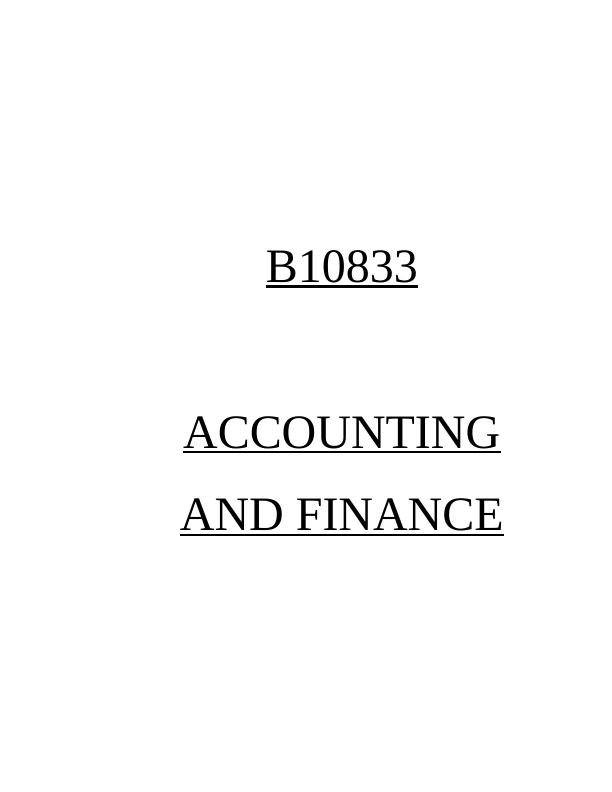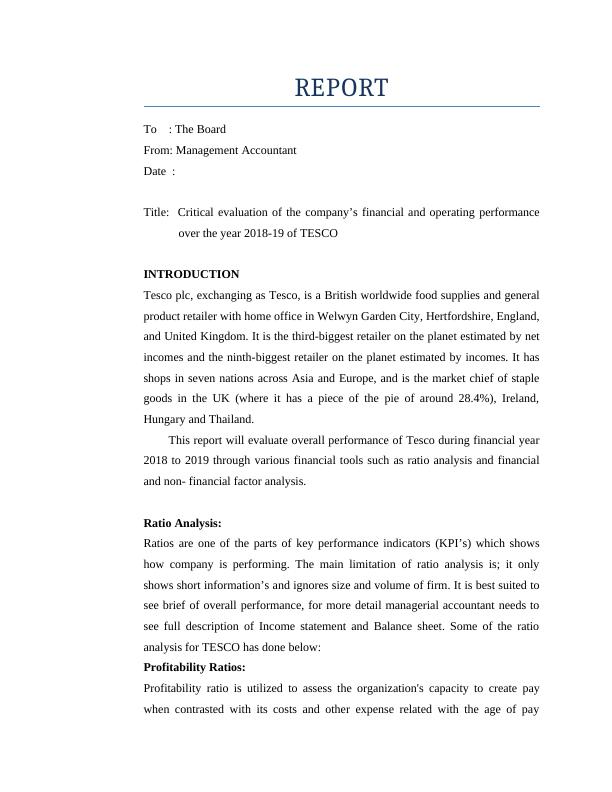Critical evaluation of Tesco's financial and operating performance
Added on 2023-01-12
14 Pages2873 Words31 Views
B10833
ACCOUNTING
AND FINANCE
ACCOUNTING
AND FINANCE

REPORT
To : The Board
From: Management Accountant
Date :
Title: Critical evaluation of the company’s financial and operating performance
over the year 2018-19 of TESCO
INTRODUCTION
Tesco plc, exchanging as Tesco, is a British worldwide food supplies and general
product retailer with home office in Welwyn Garden City, Hertfordshire, England,
and United Kingdom. It is the third-biggest retailer on the planet estimated by net
incomes and the ninth-biggest retailer on the planet estimated by incomes. It has
shops in seven nations across Asia and Europe, and is the market chief of staple
goods in the UK (where it has a piece of the pie of around 28.4%), Ireland,
Hungary and Thailand.
This report will evaluate overall performance of Tesco during financial year
2018 to 2019 through various financial tools such as ratio analysis and financial
and non- financial factor analysis.
Ratio Analysis:
Ratios are one of the parts of key performance indicators (KPI’s) which shows
how company is performing. The main limitation of ratio analysis is; it only
shows short information’s and ignores size and volume of firm. It is best suited to
see brief of overall performance, for more detail managerial accountant needs to
see full description of Income statement and Balance sheet. Some of the ratio
analysis for TESCO has done below:
Profitability Ratios:
Profitability ratio is utilized to assess the organization's capacity to create pay
when contrasted with its costs and other expense related with the age of pay
To : The Board
From: Management Accountant
Date :
Title: Critical evaluation of the company’s financial and operating performance
over the year 2018-19 of TESCO
INTRODUCTION
Tesco plc, exchanging as Tesco, is a British worldwide food supplies and general
product retailer with home office in Welwyn Garden City, Hertfordshire, England,
and United Kingdom. It is the third-biggest retailer on the planet estimated by net
incomes and the ninth-biggest retailer on the planet estimated by incomes. It has
shops in seven nations across Asia and Europe, and is the market chief of staple
goods in the UK (where it has a piece of the pie of around 28.4%), Ireland,
Hungary and Thailand.
This report will evaluate overall performance of Tesco during financial year
2018 to 2019 through various financial tools such as ratio analysis and financial
and non- financial factor analysis.
Ratio Analysis:
Ratios are one of the parts of key performance indicators (KPI’s) which shows
how company is performing. The main limitation of ratio analysis is; it only
shows short information’s and ignores size and volume of firm. It is best suited to
see brief of overall performance, for more detail managerial accountant needs to
see full description of Income statement and Balance sheet. Some of the ratio
analysis for TESCO has done below:
Profitability Ratios:
Profitability ratio is utilized to assess the organization's capacity to create pay
when contrasted with its costs and other expense related with the age of pay

during a specific period. This proportion speaks to the conclusive outcome of the
organization. Some of the types of profitability ratios are discussed below:
1. Gross profit margin:
This ratio is also used to measure the segment revenue. A high ratio
represents the greater profit margin and it’s good for the company. Gross
profit margin of Tesco is same as 2018; because it maintains cost of sales
with increase in revenue.
2. Net profit margin:
The net profit ratio gives an indication of the percentage of sales value that
the firm has retained as profit. A high ratio represents a positive return in
the company and better the company is. It is also showing 6% in both
years.
3. Return on Capital Employed:
The return on capital employed ratio is considered by many investors as
most important ratio; because here profit is compared with amount of
funds invested by owner of the company.
A high ratio represents better the company is. Tesco’s return on capital
employed exceeds 2018 and hence favorable for company.
4. Return on Shareholders Capital Employed:
= Profit Available to shareholders × 100 = X %
Equity (Shareholders Capital Employed)
organization. Some of the types of profitability ratios are discussed below:
1. Gross profit margin:
This ratio is also used to measure the segment revenue. A high ratio
represents the greater profit margin and it’s good for the company. Gross
profit margin of Tesco is same as 2018; because it maintains cost of sales
with increase in revenue.
2. Net profit margin:
The net profit ratio gives an indication of the percentage of sales value that
the firm has retained as profit. A high ratio represents a positive return in
the company and better the company is. It is also showing 6% in both
years.
3. Return on Capital Employed:
The return on capital employed ratio is considered by many investors as
most important ratio; because here profit is compared with amount of
funds invested by owner of the company.
A high ratio represents better the company is. Tesco’s return on capital
employed exceeds 2018 and hence favorable for company.
4. Return on Shareholders Capital Employed:
= Profit Available to shareholders × 100 = X %
Equity (Shareholders Capital Employed)

This ratio measures Profitability of equity fund invested the company. It
also measures how profitably owner’s funds have been utilized to generate
company’s revenues. A high ratio represents better the company is.
Tesco’s return on equity is 12% in 2018 and it reduced to 9% in 2019;
which is bad indicator for company.
Activity Ratios:
This ratio quantifies how productively the business is running (McMahon, and et.
Al., 1993). Types of activity ratios are discussed below:
1. Inventory (Stock) Turnover Ratio:
This ratio gives an information of how often inventory held by company is
sold during the period. A high ratio is good for the company. Low ratio
indicated that stock is not consumed for a longer period of time. Data of
2019 and 2018 shows ratio of 24.49 and 23.91; which indicates favorable
change.
2. Total Net Assets Turnover Ratio:
The net asset turnover ratio is used to know how well company is utilizing
its resources. A high ratio represents efficient utilization of total Assets in
generating sales. Tesco showing 1.30 in 2019 and 1.28 in 2018; which
indicates company has efficiently utilized resources comparing to previous
year.
also measures how profitably owner’s funds have been utilized to generate
company’s revenues. A high ratio represents better the company is.
Tesco’s return on equity is 12% in 2018 and it reduced to 9% in 2019;
which is bad indicator for company.
Activity Ratios:
This ratio quantifies how productively the business is running (McMahon, and et.
Al., 1993). Types of activity ratios are discussed below:
1. Inventory (Stock) Turnover Ratio:
This ratio gives an information of how often inventory held by company is
sold during the period. A high ratio is good for the company. Low ratio
indicated that stock is not consumed for a longer period of time. Data of
2019 and 2018 shows ratio of 24.49 and 23.91; which indicates favorable
change.
2. Total Net Assets Turnover Ratio:
The net asset turnover ratio is used to know how well company is utilizing
its resources. A high ratio represents efficient utilization of total Assets in
generating sales. Tesco showing 1.30 in 2019 and 1.28 in 2018; which
indicates company has efficiently utilized resources comparing to previous
year.

End of preview
Want to access all the pages? Upload your documents or become a member.
Related Documents
Evaluating TESCO's Financial Performance Using Accounting Ratioslg...
|8
|1981
|162
Financial Performance Analysis of Tesco: A Ratio Analysislg...
|7
|1961
|136
Managing Financial Resources - Analysis of Enero Group Limitedlg...
|13
|2661
|63
Financial Management: Valuation and Capital Structurelg...
|11
|2354
|55
Managerial Finance: Sainsbury and Tescolg...
|19
|3560
|162
Financial Analysis and Company Valuation of BAE Systemslg...
|13
|3119
|57
